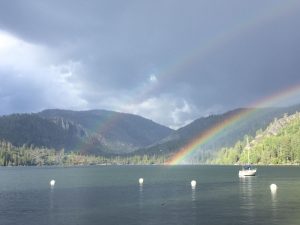What Might El Niňo Bring The Mother Lode?
Sonora, CA – Current efforts to pin probabilities of wet El Niňo weather in the Sierras seem as elusive as getting a good thwack! on a piñata while blindfolded.
“There is a lot of information out there about the possibility of an El Niňo weather year and whether this will bring precipitation our way,” admits Tuolumne County Office of Emergency Services Coordinator Tracie Riggs. She points to the latest data from the Department of Water Resources (DWR) and Western Regional Climate Center (WRCC), which demonstrate that previous El Niňo weather systems have resulted in both very low and very high rainfall. “Essentially,” she says, “we are being told that El Niňo has no strong correlation to above normal precipitation for Central California.”
A NWS Tuolumne County Drought Task Force report on El Niňo, which provides specific figures relating to Sonora, indicates that from last October through July 9, the city received 16.5 inches of rain; roughly 48 percent of its “normal” rainfall of about 35 inches.
The document includes a current Climate Prediction Center (CPC) forecast for a greater than 90 percent chance that El Niňo conditions will continue through the winter of this next water-year; and an 80 percent likelihood for it to continue through early spring. However, the agencies state it is too early to tell what El Niño might mean for drought-stricken California overall, additionally providing back up data that clearly demonstrate no strong correlation for many parts of the state, including the Mother Lode.
Local Statistics
Data specifically pertaining to Sonora, dating back to 1950, indicates that there have been five strong El Nino events since then; of them, three that resulted in 60 percent above normal precipitation. There have also been nine moderate El Niňos; three that brought 33 percent above normal rainfall; of seven weak events, two delivered rains 29 percent above normal.
In a Water Year 2015 handout, DWR and WRCC indicate that the El Niño-Southern Oscillation (ENSO), which is one of the most studied climate phenomena, provides some predictive guidance in parts of the US, and that this year’s warm ocean and sea-surface temperatures are signaling a strong El Niño event. Whether El Niño will make a difference for the water-year, the agencies indicate upfront: maybe not
Looking at the Northern Sierra eight-station index* over five strong El Niño winters that occurred during the drought years of 1958, 1973, 1983, 1992, and 1998, water-year precipitation totals ranged from 36 inches (72 percent of average) in 1992, to 88.5 inches (177 percent of average) in 1983. The 1973 total of 51.6 inches was 103 percent of average.
So, as the forecasting agencies point out, a strong El Niño happening in a continuing drought water-year might result in drier-than-normal precipitation, as in 1992; an “average” year, like 1973; or a wet year, like 1983. Keep up those rain dances.
*Note: The precipitation index covers the mountainous regions that extend from east of Sacramento to above Shasta Dam.

